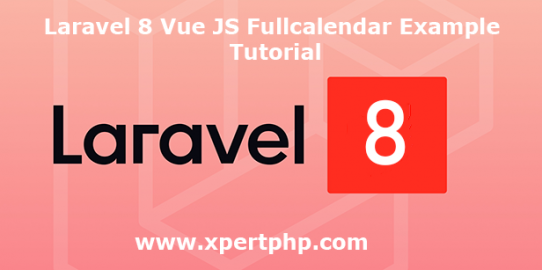Today, We will learn step by step how to integrate vuejs fullcalendar in laravel 8(Laravel 8 Vue JS Fullcalendar Example Tutorial). so we will give you a simple example of a Fullcalendar in Laravel with Vue. we are using npm vue-full-calendar and Moment packages in this fullcalendar example.
FullCalendar is useful for appointment booking, event scheduling, task management, and see which peoples are leave in this current month, etc.
You can also see below our Laravel 8 Fullcalendar Example Tutorial.
So you can see our example source code.
Overview
Step 1: Install laravel
Step 2: Setting Database Configuration
Step 3: Create Table using migration
Step 4: Create Route
Step 5: Create a Model and Controller
Step 6: Install Vue
Step 7: Create Component and update app.js
Step 8: Update Blade Files
Step 9: Run Our Laravel Application
Step 1: Install laravel
Install the laravel using the below command.
1 | composer create-project --prefer-dist laravel/laravel laravel8_vuejs_fullcalendar |
Step 2: Setting Database Configuration
After the complete installation of laravel. we have to database configuration. now we will open the .env file and change the database name, username, password in the .env file. See below changes in a .env file.
1 2 3 4 5 6 | DB_CONNECTION=mysql DB_HOST=127.0.0.1 DB_PORT=3306 DB_DATABASE=Enter_Your_Database_Name(laravel8_vuejs_fullcalendar) DB_USERNAME=Enter_Your_Database_Username(root) DB_PASSWORD=Enter_Your_Database_Password(root) |
Step 3: Create Table using migration
Now, We need to create a migration. so we will below command using create the bookings table migration.
Create The table using the below command.
1 | php artisan make:migration create_bookings_table --create=bookings |
After complete migration. we need the below changes in the database/migrations/create_bookings_table file.
1 2 3 4 5 6 7 8 9 10 11 12 13 14 15 16 17 18 19 20 21 22 23 24 25 26 27 28 29 30 31 32 | <?php use Illuminate\Support\Facades\Schema; use Illuminate\Database\Schema\Blueprint; use Illuminate\Database\Migrations\Migration; class CreateBookingsTable extends Migration { /** * Run the migrations. * * @return void */ public function up() { Schema::create('bookings', function (Blueprint $table) { $table->bigIncrements('id'); $table->string('title'); $table->date('start'); $table->date('end'); $table->timestamps(); }); } /** * Reverse the migrations. * * @return void */ public function down() { Schema::dropIfExists('bookings'); } } ?> |
Run the below command. after the changes above file.
1 | php artisan migrate |
Step 4: Create Route
Add the following route code in the “routes/web.php” file.
1 2 3 4 5 6 7 8 9 10 11 12 13 14 15 16 17 18 19 20 21 22 | <?php use App\Http\Controllers\FullCalendarController; /* |-------------------------------------------------------------------------- | Web Routes |-------------------------------------------------------------------------- | | Here is where you can register web routes for your application. These | routes are loaded by the RouteServiceProvider within a group which | contains the "web" middleware group. Now create something great! | */ Route::get('/', function () { return view('welcome'); }); Route::get('/booking',[FullCalendarController::class, 'index']); ?> |
Step 5: Create a Model and Controller
Now, We will create the controller and model using the below command and paste the below code into this controller.
1 | php artisan make:controller FullCalendarController |
1 | php artisan make:model Booking |
FullCalendarController.php
1 2 3 4 5 6 7 8 9 10 11 12 13 14 15 16 17 18 19 | <?php namespace App\Http\Controllers; use Illuminate\Http\Request; use App\Models\Booking; use Redirect,Response; class FullCalendarController extends Controller { public function index() { $bookings = Booking::get(['title','start','end']); return response()->json(["bookings" => $bookings]); } } ?> |
Booking.php
1 2 3 4 5 6 7 8 9 10 11 12 | <?php namespace App\Models; use Illuminate\Database\Eloquent\Factories\HasFactory; use Illuminate\Database\Eloquent\Model; class Booking extends Model { use HasFactory; protected $fillable = ['title','start','end']; } ?> |
Step 6: Install Vue
In this step, go to the project directory using the command prompt. after then we will install Vue js in laravel 8 and run fullcalender dependency.
1 2 3 4 5 6 7 | php artisan preset vue npm install npm install --save vue-full-calendar npm install --save babel-runtime npm install babel-preset-stage-2 --save-dev npm install moment --save |
Step 7: Create Component and update app.js
resources/js/components/FullCalendarComponent.vue
1 2 3 4 5 6 7 8 9 10 11 12 13 14 15 16 17 18 19 20 21 22 23 24 | <template> <div class="container"> <full-calendar :event-sources="bookingSources"></full-calendar> </div> </template> <script> export default{ data() { return { bookingSources: [ { events(start, end, timezone, callback) { axios.get('http://localhost:8000/booking').then(response => { callback(response.data.bookings) }) }, color: 'yellow', textColor: 'black', } ] } } } </script> |
resources/js/app.js
1 2 3 4 5 6 7 8 9 10 11 | require('./bootstrap'); import 'fullcalendar/dist/fullcalendar.css'; window.Vue = require('vue'); import FullCalendar from 'vue-full-calendar'; //Import Full-calendar Vue.use(FullCalendar); Vue.component('fullcalendar-component', require('./components/FullCalendarComponent.vue').default); const app = new Vue({ el: '#app', }); |
Step 8: Update Blade Files
So finally, first we need to create the app.blade.php file in the “resources/views/layouts/” and Update the welcome.blade.php file in the “resources/views/” directory. so you can see the below code.
resources/views/layouts/app.blade.php
1 2 3 4 5 6 7 8 9 10 11 12 13 14 15 16 17 18 19 20 21 22 23 24 | <!doctype html> <html> <head> <meta charset="utf-8"> <meta name="viewport" content="width=device-width, initial-scale=1"> <meta name="csrf-token" content="{{ csrf_token() }}"> <title>{{ config('app.name', 'Laravel') }}</title> <script src="{{ asset('js/app.js') }}" defer></script> <link href="{{ asset('css/app.css') }}" rel="stylesheet"> @stack('fontawesome') </head> <body> <div id="app"> <main class="py-4"> @yield('content') </main> </div> </body> </html> |
welcome.blade.php
1 2 3 4 5 6 7 8 9 10 11 12 13 14 15 | @extends('layouts.app') @section('content') <div class="container"> <div class="row justify-content-center"> <div class="col-md-8"> <div class="card"> <div class="card-header">Laravel 8 Vue JS Fullcalendar Example Tutorial</div> <div class="card-body"> <fullcalendar-component></fullcalendar-component> </div> </div> </div> </div> </div> @endsection |
Step 9: Run Our Laravel Application
We can start the server and run this example using the below command.
1 2 3 | npm run dev //or npm run watch |
Now we will run our example using the below Url in the browser.
1 | http://127.0.0.1:8000/users |
